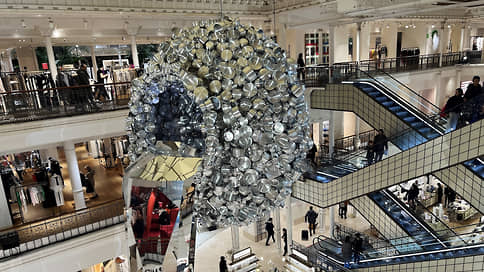Empty pots of “Ladies’ Happiness” – Newspaper Kommersant No. 23 (7468) of 02/08/2023
[ad_1]

For the eighth time, the Parisian department store Bon Marche is giving artists the three-story space of the main hall for a large-scale exhibition. This January, the famous Indian Subodh Gupta became a guest with the Sangam project. The Kommersant correspondent in France admired the sparkling empty pots Alexey Tarkhanov.
Subodh Gupta, 59, returns to Paris five years after his 2018 retrospective at La Monnaie Museum. Then the opening and symbol of the exhibition was the famous giant skull, assembled from shiny kitchen utensils – “The Very Hungry God.” This year, empty pots and bowls once again became the material for three monumental Gupta sculptures. They are exhibited under a glass roof in the atrium of the LVMH-owned old Parisian store Bon Marche, sung by Emile Zola in the novel A Lady’s Happiness.
The project is called “Sangam” after the place of pilgrimage in India. It’s funny, but this name is more familiar in Russia than in France – in the era of the great Soviet-Indian friendship, “Sangam” was on our screens, Raj Kapoor’s film about a love triangle, filmed in 1964, just in the year of the birth of the artist Gupta .
Two 12-meter-high column sculptures are Sangam I and Sangam II. The first is a traditional Indian pot, the second is an international bucket, both of them are made up of 5,000 aluminum pots, like pixels, and the falling jets are depicted by the mirror faces of the columns. But for my taste, the sculptures are more like sparkling long-stemmed primrose flowers or hallucinogenic mushrooms with a heavy hat.
On the top floor of the department store, a round yurt hut was built from 2,500 pots, jugs, bowls, lids, this time not sparkling, but spent by life. This installation is called “The Proust Effect”, and it can be enjoyed both outside and inside the yurt.
You can slide past the other two, going up and down on the escalators located between them. You may not even notice them behind the variegation and variety of things in the corners and showcases – after all, Bon Marche is not a museum, but a store.
This is what makes the project so interesting. The winter exhibition at Bon Marche has already become a tradition, like the Paris fairs of contemporary art. Every year, one of the world-famous masters is exhibited here, such as the Chinese Ai Weiwei, who opened the parade in 2016, and the Portuguese Joanna Vasconcelos, who continued in 2019. This is a form of dialogue between the world of contemporary art and the world of consumption – not in the form of abstraction, but in real forms and in a real interior.
Gupta’s showcase is inviting to the shop windows, which display his installations of a filthy gas stove, a shabby cabinet, sewing machines with a carpet of colored broken plates. The contradiction is immediately stated. For the first time behind the mirrored glass of Bon Marche lies something that cannot be bought, not because it is sky-high luxury at atomic prices. On the contrary, it looks like rubbish from a flea market. But assembled by the artist and placed in the windows of the most expensive Parisian department store, it takes on a completely different meaning than on the counter of a junk dealer. And, by the way, a different price.
Evil critics have already said that the brilliant silver streams pouring from the vessels resemble silver flowing into the pockets of LVMH owners, since in French argent it is both “silver” and “money”. Leftist ideas are popular, but, as usual, primitive. In the anti-bourgeois paradigm, it is easy to blame an author who has entered into an alliance with luxury merchants. But Gupta is not the best target for this, he never declared himself as an elitist artist, no matter how much he was loved and collected by the financial elite. On the contrary, he always talks about his roots, about his people, numerous and not too rich, and is clearly aware of what he is doing and why: “The audience here is completely different from the one I usually address. Because people who go shopping don’t necessarily go to museums or art galleries,” says the artist.
In a building where everything is for sale and everything has a price, Gupta sculptures cannot be bought and taken home. Supersizes seem to warn about this, although, here’s a paradox, the very objects from which they are composed are extremely prosaic. They are just pans, and of such low quality and “social status” that they could not even be in the Bon Marche hardware department, if there was one.
The artist seems to be saying that art, almost religious, can grow on the most rubbish roots. He talks about the sacred vessels from which water flows at the “feast of pitchers” during a pilgrimage to the place of the magical confluence of three rivers: two real, one mythical. For the sake of the January bath, which washes away sins, millions are striving for Indian Prayagraj.
We are talking about millions in Paris. By placing the image of the sacred vessels from which the gods drank the divine drink that gives immortality in the interior of a store that has been attracting people for almost two centuries, Gupta talks about how religious pilgrimage and consumer pilgrimage merge in our time: “With all these people who come from all over the world, meet in one place and form a kind of human wave, Bon Marche reminds me so much of the Sangam.”
[ad_2]
Source link






